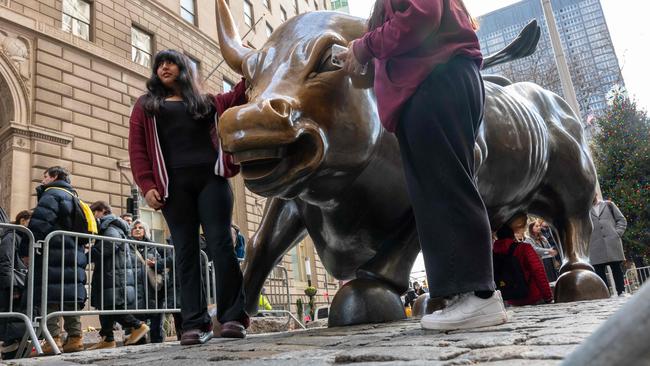Bank of America predicts four interest rate cuts in 2024
Global shares are rising as economists begin to embrace the market’s so-called ‘Goldilocks’ scenario for the US, despite China’s struggles.

Business
Don't miss out on the headlines from Business. Followed categories will be added to My News.
Global shares are rising as economists warm to the market’s Goldilocks scenario for the US, even as China’s sharemarket continues to grapple with a stalled economic outlook.
Bank of America took a more positive view on US economic resilience and disinflation last month, leading it to predict four rate cuts of 25 basis points by the Federal Reserve in 2024.
That’s more than Fed official’s latest projections of three rate cuts in 2024 and in line with the consensus view that the Fed funds rate will be cut four times to a range of 4.25-4.5 per cent.
But economists are still a long way from market pricing of up to six cuts in 2024 and more in 2025.
If the Fed were to cut the Fed funds rate by that much in the absence of a recession it would be very positive for stocks.
The Australian stockmarket was anticipating a positive start to 2024 from Wall Street.
The ASX 200 index rose 0.5 per cent to 7627.8 points on Tuesday, just 1.1 points shy of a record closing high reached in August 2021.
The US’s S&P 500 was only 0.6 per cent away from a record high. In the final two months of 2023, Australia’s ASX 200 jumped 11.6 per cent as the S&P 500 soared 13.3 per cent, led by a 16 per cent rise in the Nasdaq 100.

Meanwhile, China’s CSI 300 fell 1.3 per cent despite a rousing speech from President Xi Jinping over the weekend, where he vowed to get on top of economic fragility.
In its revised US economic outlook last month, Bank of America argued that incoming data was “signalling that the US economy can enjoy both modest growth and disinflation simultaneously”.
“Despite weak readings on consumer confidence, the consumer remains inclined to keep its spending up,” BofA US economist Michael Gapen said.
The bank revised up its outlook for the US economy, predicting real GDP growth of 1.2 per cent in 2024. That is near Bloomberg’s current consensus estimate that economic growth will slow to 1.3 per cent this year versus 2.4 per cent in 2023, before picking up to 1.7 per cent in 2025.
While the consensus estimate of the probability of US recession in the next year is elevated – near 50 per cent – it’s well down on early 2023 levels around 70 per cent.
Given the faster than expected disinflation in 2023, the market is taking a “glass half full” view of the US economy. But it may be sensitive to push-back from US policy makers against the chance of rate cuts starting by March – now priced as a 70 per cent chance in the US.
Mr Gapen expected US core personal consumption expenditure inflation to fall to 2.5 per cent in 2024, close to Bloomberg’s consensus estimate of 2.6 per cent.
He attributed the gap between his funds rate forecast and market pricing to a combination of market expectations of a faster slowdown in inflation and or higher recession risk.

“We have shifted in the direction of lower recession risk while maintaining a forecast for inflation that is stickier than the market-implied path,” Mr Gapen said.
Like most economists he was too negative last year on account of surging inflation, a rising personal saving rate, and a Fed that was prepared to err on the side of doing more rather than less in its fight to bring inflation down. “The message was that the US was likely to endure a period of below trend growth and ‘pain’ in labour markets as medicine to cure the ills of inflation,” Mr Gapen added. “In retrospect we were too negative on the US outlook and the economy retained significant resilience to higher interest rates, leading us to revise our outlook from a mild recession to a soft landing.”
As for the Fed’s current quantitative tightening, he expects the Federal Reserve to keep going until June.
That may be a trade-off that FOMC participants make to get the rate cut cycle started in March; begin rate cuts but let a shrinking balance sheet provide some additional tightening in the background to counter concerns financial conditions may have eased too much.
Citi economists say the abrupt pivot away from rate hikes by the Federal Reserve at its meeting last month caused a significant easing of financial conditions, supporting the rallies in stocks and bonds.
The bank’s global asset allocation team upgraded US equities in early November on the basis of strong seasonal factors and its view that a recession would be delayed until the June quarter.
But they said a potential recession could make early 2024 a more difficult period for equities.
In their view, a long-term buying opportunity for US equities “happens when the recession is halfway done”, and “should Citi’s recession call pan out, markets may be in for a weaker first half”.
In an updated view last week, Citi head of global macro, asset allocation and emerging market strategy Dirk Willer said the bank was “tactically bullish, but longer-term challenges remain”.
An expected growth slowdown this year “remains a concern” and markets are “fully pricing a soft-landing in our view”, Mr Willer said.
Originally published as Bank of America predicts four interest rate cuts in 2024



